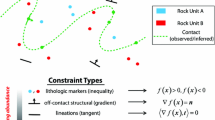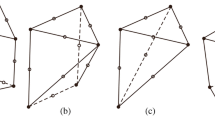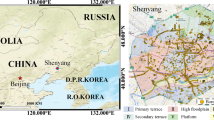Abstract
Implicit methods for modeling geological structures such as stratigraphy and faults have been developed for more than a decade, and they have made automatic model construction feasible. The implicit potential field method is such a method that is capable of incorporating multiple types of data including contact points for geological boundaries and their measured orientations. The implicit potential field method relies on the solution of a co-kriging system. However, applying the method to 3D modeling of large-scale geological structures constrained to dense data and strict geological rules remains challenging. Due to the non-stationary and complex nature of large-scale geological structures, and difficulty in estimating an adequate variogram model, performing global interpolation with all dense data together may create geologically unrealistic artifacts. We propose a framework that uses a divide-and-conquer strategy. The core idea is to create intermediate 3D geological models that match subsets of data and then recombine them into a single large 3D geological model, while maintaining data and geological rule constraints. We also prove that linear combinations of potential fields preserve properties of conditioning. The paper presents an application of the framework in modeling the stratigraphy model of a large banded iron formation in Western Australia with dense boreholes, but scarce orientation measurements.




















Similar content being viewed by others
References
Aug, C. (2004). Modélisation géologique 3D et caractérisation des incertitudes par la méthode du champ de potential. Thesis, MINES ParisTech.
Aydin, O., & Caers, J. K. (2017). Quantifying structural uncertainty on fault networks using a marked point process within a Bayesian framework. Tectonophysics, 712, 101–124.
Breiman, L. (1996). Bagging predictors. Machine Learning, 24(2), 123–140.
Calcagno, P., Chilès, J. P., Courrioux, G., & Guillen, A. (2008). Geological modelling from field data and geological knowledge: Part I. Modelling method coupling 3D potential-field interpolation and geological rules. Physics of the Earth and Planetary Interiors, 171(1–4), 147–157.
Carmichael, T., & Ailleres, L. (2016). Method and analysis for the upscaling of structural data. Journal of Structural Geology, 83, 121–133.
Caumon, G. (2010). Towards stochastic time-varying geological modeling. Mathematical Geosciences, 42(5), 555–569.
Caumon, G., Gray, G., Antoine, C., & Titeux, M. O. (2012). Three-dimensional implicit stratigraphic model building from remote sensing data on tetrahedral meshes: Theory and application to a regional model of La Popa Basin, NE Mexico. IEEE Transactions on Geoscience and Remote Sensing, 51(3), 1613–1621.
Caumon, G., Lepage, F., Sword, C. H., & Mallet, J. L. (2004). Building and editing a sealed geological model. Mathematical Geology, 36(4), 405–424.
Caumon, G., Tertois, A. L., & Zhang, L. (2007). Elements for stochastic structural perturbation of stratigraphic models. In EAGE conference on petroleum geostatistics (pp. cp-32). European Association of Geoscientists & Engineers.
Cherpeau, N., Caumon, G., Caers, J., & Lévy, B. (2012). Method for stochastic inverse modeling of fault geometry and connectivity using flow data. Mathematical Geosciences, 44(2), 147–168. https://doi.org/10.1007/s11004-012-9389-2
Chilès, J. P., Aug, C., Guillen, A., & Lees, T. (2004), November. Modelling the geometry of geological units and its uncertainty in 3D from structural data: The potential-field method. In Proceedings of international symposium on orebody modelling and strategic mine planning, Perth, Australia (Vol. 22, p. 24).
Chilès, J. P., & Delfiner, P. (2012). Geostatistics: Modeling spatial uncertainty (Vol. 713). Wiley.
Cowan, E. J., Beatson, R. K., Ross, H. J., Fright, W. R., McLennan, T. J., Evans, T. R., Carr, J. C., Lane, R. G., Bright, D. V., Gillman, A. J., & Oshust, P. A. (2003), November. Practical implicit geological modelling. In Fifth international mining geology conference (pp. 17–19). Australian Institute of Mining and Metallurgy Bendigo, Victoria.
De la Varga, M., Schaaf, A., & Wellmann, F. (2019). GemPy 1.0: open-source stochastic geological modeling and inversion. Geoscientific Model Development, 12(1), 1–32.
Frank, T., Tertois, A. L., & Mallet, J. L. (2007). 3D-reconstruction of complex geological interfaces from irregularly distributed and noisy point data. Computers & Geosciences, 33(7), 932–943.
Gonçalves, Í. G., Kumaira, S., & Guadagnin, F. (2017). A machine learning approach to the potential-field method for implicit modeling of geological structures. Computers & Geosciences, 103, 173–182.
Grose, L., Laurent, G., Aillères, L., Armit, R., Jessell, M., & Cousin-Dechenaud, T. (2018). Inversion of structural geology data for fold geometry. Journal of Geophysical Research: Solid Earth, 123(8), 6318–6333.
Guillen, A., Calcagno, P., Courrioux, G., Joly, A., & Ledru, P. (2008). Geological modelling from field data and geological knowledge: Part II. Modelling validation using gravity and magnetic data inversion. Physics of the Earth and Planetary Interiors, 171(1–4), 158–169.
Harmsworth, R. A., Kneeshaw, M., Morris, R. C., Robinson, C. J., & Shrivastava, P. K. (1990). BIF-derived iron ores of the Hamersley Province. Geology of the Mineral Deposits of Australia and Papua New Guinea, 1, 617–642.
Irakarama, M., Laurent, G., Renaudeau, J., & Caumon, G. (2020). Finite difference implicit structural modeling of geological structures. Mathematical Geosciences. https://doi.org/10.1007/s11004-020-09887-w
Jarna, A., Bang-Kittilsen, A., Haase, C., Henderson, I. H. C., Høgaas, F., Iversen, S., & Seither, A. (2015). 3-Dimensional geological mapping and modeling activities at the geological survey of Norway. The International Archives of Photogrammetry, Remote Sensing and Spatial Information Sciences, 40, 11.
Journel, A. G. (1999). Markov models for cross-covariances. Mathematical Geology, 31(8), 955–964.
Kleijnen, J. P., & van Beers, W. C. (2020). Prediction for big data through Kriging: Small sequential and one-shot designs. American Journal of Mathematical and Management Sciences. https://doi.org/10.1080/01966324.2020.1716281
Lajaunie, C., Courrioux, G., & Manuel, L. (1997). Foliation fields and 3D cartography in geology: Principles of a method based on potential interpolation. Mathematical Geology, 29(4), 571–584.
Lascelles, D. F. (2012). Banded iron formation to high-grade iron ore: A critical review of supergene enrichment models. Australian Journal of Earth Sciences, 59(8), 1105–1125.
Laurent, G. (2016). Iterative thickness regularization of stratigraphic layers in discrete implicit modeling. Mathematical Geosciences, 48(7), 811–833.
Laurent, G., Ailleres, L., Grose, L., Caumon, G., Jessell, M., & Armit, R. (2016). Implicit modeling of folds and overprinting deformation. Earth and Planetary Science Letters, 456, 26–38.
Mallet, J. L. (1997). Discrete modeling for natural objects. Mathematical Geology, 29(2), 199–219.
Mallet, J. L. (2014). Elements of mathematical sedimentary geology: The GeoChron model. EAGE Publications.
Manchuk, J. G., & Deutsch, C. V. (2019). Boundary modeling with moving least squares. Computers & Geosciences, 126, 96–106.
Mariethoz, G., & Caers, J. (2014). Multiple-point geostatistics: Stochastic modeling with training images. Wiley.
Remy, N., Boucher, A., & Wu, J. (2009). Applied geostatistics with SGeMS: A user’s guide. Cambridge University Press.
Renaudeau, J. (2019). Continuous formulation of implicit structural modeling discretized with mesh reduction methods. Thesis, Université de Lorraine.
Renaudeau, J., Irakarama, M., Laurent, G., Maerten, F., & Caumon, G. (2019a). Implicit modelling of geological structures: A Cartesian grid method handling discontinuities with ghost points. WIT Transactions on Engineering Sciences, 122, 189–199.
Renaudeau, J., Malvesin, E., Maerten, F., & Caumon, G. (2019b). Implicit structural modeling by minimization of the bending energy with moving least squares functions. Mathematical Geosciences, 51(6), 693–724.
Rousseeuw, P. J., & Driessen, K. V. (1999). A fast algorithm for the minimum covariance determinant estimator. Technometrics, 41(3), 212–223.
Schaaf, A., de la Varga, M., Wellmann, F., & Bond, C. E. (2020). Constraining stochastic 3-D structural geological models with topology information using Approximate Bayesian Computation using GemPy 2.1. Geoscientific Model Development Discussions, 18, 1–24.
Thornton, J. M., Mariethoz, G., & Brunner, P. (2018). A 3D geological model of a structurally complex Alpine region as a basis for interdisciplinary research. Scientific Data, 5(1), 1–20.
Trendall, A. F. (1983). The hamersley basin. In A.F. Trendall, & R. C. Morris (Eds.), Developments in precambrian geology (Vol. 6, pp. 69–129). Elsevier.
van Stein, B., Wang, H., Kowalczyk, W., Bäck, T., & Emmerich, M. (2015). Optimally weighted cluster kriging for big data regression. In International symposium on intelligent data analysis (pp. 310–321). Springer, Cham.
van Stein, B., Wang, H., Kowalczyk, W., Emmerich, M., & Bäck, T. (2020). Cluster-based Kriging approximation algorithms for complexity reduction. Applied Intelligence, 50(3), 778–791.
Vargas-Guzmán, J. A., & Yeh, T. C. J. (1999). Sequential kriging and cokriging: Two powerful geostatistical approaches. Stochastic Environmental Research and Risk Assessment, 13(6), 416–435.
Vollgger, S. A., Cruden, A. R., Ailleres, L., & Cowan, E. J. (2015). Regional dome evolution and its control on ore-grade distribution: Insights from 3D implicit modelling of the Navachab gold deposit, Namibia. Ore Geology Reviews, 69, 268–284.
Wellmann, J. F., Lindsay, M., Poh, J., & Jessell, M. (2014). Validating 3-D structural models with geological knowledge for improved uncertainty evaluations. Energy Procedia, 59, 374–381.
Wellmann, J. F., De La Varga, M., Murdie, R. E., Gessner, K., & Jessell, M. (2018). Uncertainty estimation for a geological model of the Sandstone greenstone belt, Western Australia–insights from integrated geological and geophysical inversion in a Bayesian inference framework. Geological Society, London, Special Publications, 453(1), 41–56. https://doi.org/10.1144/SP453.12
Yang, L., Hyde, D., Grujic, O., Scheidt, C., & Caers, J. (2019). Assessing and visualizing uncertainty of 3D geological surfaces using level sets with stochastic motion. Computers & Geosciences, 122, 54–67.
Zhong, D., & Wang, L. (2020). Solution optimization of RBF interpolation for implicit modeling of orebody. IEEE Access, 8, 13781–13791.
Acknowledgments
The project is funded by BHP. We are grateful to Alexandre Boucher (Ar2Tech) and Ilnur Minniakhmetov for their wonderful advices and comments. We would like to thank Dr. Gautier Laurent and the anonymous reviewer for their careful reading of the manuscript and their insightful comments.
Author information
Authors and Affiliations
Corresponding author
Appendix
Appendix
In the appendix, we prove that the conditioning to contact points and orientations is preserved with linear combination of two potential fields. Let \(f\left( \varvec{x} \right)\varvec{~}\) and \(g\left( \varvec{x} \right)\) denote two potential fields, \(h\left( \varvec{x} \right)\) the linearly combined potential field and \(w\left( \varvec{x} \right)\) the spatially varying weight.
Statement 1 The linear combination of two potential fields maintains fitting contact points that both potential fields already fit.
Proof 1 At contact points locations \(\varvec{x}_{c}\), the linear combination of two potential fields \(f\left( {\varvec{x}_{c} } \right)\) and \(g\left( {\varvec{x}_{c} } \right)\) is:
Let \(\tilde{f}\) and \(\tilde{g}\) denote iso-values that fit \(\varvec{x}_{c}\) for \(f\left( {\varvec{x}_{c} } \right)\varvec{~}\) and \(g\left( {\varvec{x}_{c} } \right)\), respectively. Let \(\tilde{w}\) denote the weight at location \(\varvec{x}_{c}\). Then, we have:
The statement “\(h\left( \varvec{x} \right)\) fits contact points \(\varvec{x}_{c}\)”, entails “\(\tilde{h} = h\left( {\varvec{x}_{c} } \right)\)”\(:\tilde{h}~\) is the iso-value in \(h\left( \varvec{x} \right)\) that represents the boundary. We know that
so \(\tilde{h} = h\left( {\varvec{x}_{c} } \right)\) if and only if:
In other words, the iso-value used to represent the boundary in \(h\left( x \right)\) should be the linear combination of iso-values in \(f\left( \varvec{x} \right)~\) and \(g\left( \varvec{x} \right)\), with the same weight used for combining \(f\left( \varvec{x} \right)~\) and \(g\left( \varvec{x} \right)\). To make sure new boundaries fit contact points, we not only need to do linear combination for two potential fields, but we also need to do a linear combination for the thresholding values and use it to create the categorical model. □
Statement 2 For any contact point, if only one potential field fits it, then the linear combination of two potential fields maintains fitting that contact point if the fitted potential field has a weight of 1 and the unfitted potential field has a weight of 0 at the contact point location.
Proof 2 Let us assume the potential field that fits \(\varvec{x}_{c}\) is \(f\left( {\varvec{x}_{c} } \right)\). As stated, \(w\left( {\varvec{x}_{c} } \right) = 1\), so.
and
Therefore, \(h\left( {\varvec{x}_{c} } \right)\) also fits \(\varvec{x}_{c}\) as \(f\left( {\varvec{x}_{c} } \right)\) does. This means that as long as we assign a weight of 1 to the fitted potential field at the contact point location, and a weight of 0 to the unfitted potential field, then our linearly combined potential field will fit to the contact point. □
Statement 3 The linear combination of two potential fields maintains fitting orientations that both potential fields already fit.
Proof 3 At first, we know the existing linearity of gradient theorem, which states that, for two scalar fields \(f\left( \varvec{x} \right)\) and \(g\left( \varvec{x} \right)\) at point \(\varvec{x}_{o}\), we have.
It is easy to see that if we replace \(\alpha\) with \(w\left( {\varvec{x}_{o} } \right)\), and \(\beta\) with \(1 - w\left( {\varvec{x}_{o} } \right)\), the linearity of gradient still holds.
Then, for orientation observation locations \(\varvec{x}_{o}\) where \(f\left( {\varvec{x}_{o} } \right)\) and \(g\left( {\varvec{x}_{o} } \right)~\) have the same gradients, i.e., \(\nabla f\left( {\varvec{x}_{o} } \right) = \nabla g\left( {\varvec{x}_{o} } \right)\), we can obtain the following using the linearity of gradient:
In other words, the gradient remains the same after linear combination.
Therefore, as long as we use simulated orientations with the same observed “hard data” to generate \(f\left( \varvec{x} \right)\) and \(g\left( \varvec{x} \right)\) (i.e., \(\nabla f\left( {\varvec{x}_{o} } \right) = \nabla g\left( {\varvec{x}_{o} } \right)\) for all orientation observation locations), all orientation observations will always be matched when doing linear combinations. □
Rights and permissions
About this article
Cite this article
Yang, L., Achtziger-Zupančič, P. & Caers, J. 3D Modeling of Large-Scale Geological Structures by Linear Combinations of Implicit Functions: Application to a Large Banded Iron Formation. Nat Resour Res 30, 3139–3163 (2021). https://doi.org/10.1007/s11053-021-09901-w
Received:
Accepted:
Published:
Issue Date:
DOI: https://doi.org/10.1007/s11053-021-09901-w




